For Thanksgiving’s Distro of the Week, we put openSUSE Tumbleweed Xfce through install, configuration, and multitasking tests to see how its classic tools and newer additions hold up in everyday use.
The FOSS Force Thanksgiving Day Distro of the Week — openSUSE Tumbleweed
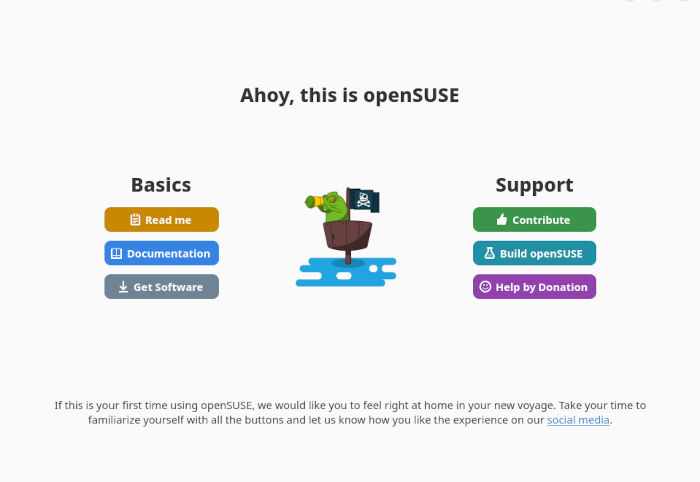
Dialing it back from our last “Operating System of the Week” with GhostBSD to this week’s merely humble “Distro of the Week,” we decided to take it easy with our Thanksgiving Day comeback and go with a well-known and stable Linux distro.
With this in mind, welcome to an oldie but goodie. We’ve downloaded the latest openSUSE Tumbleweed Xfce to put through its paces.
A Little OpenSUSE History
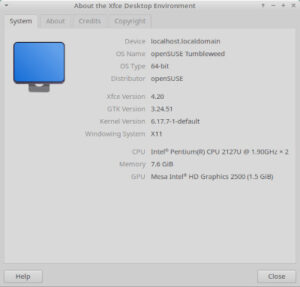
It goes without saying that openSUSE has a long history in Linux circles. The German company SUSE, an acronym for “Software und System-Entwicklung” (“Software and System Development”), created its first Linux distro in 1994, making it one of the oldest commercial distros. When Novell purchased SUSE in 2003, steps were taken to assure that a free version of the distro remained available for free, culminating in the creation of a community developed version called openSUSE in 2006.
Fast forward to today. With all of those years of development behind them, openSUSE delivers two versions – Tumbleweed and Leap. The first is a rolling release that’s continually updated from openSUSE’s development branch, while the latter uses a more traditional fixed release schedule — released every two years with only security and maintenance updates in between.
Because of this, Tumbleweed tends to provide more bleeding-edge software and features — sometimes at the expense of stability or compatibility. Leap, on the other hand, is designed for stability and is closely related to the commercial SUSE Linux Enterprise distro.
Between both Tumbleweed and Leap, openSUSE offers separate editions Gnome, KDE Plasma, and Xfce. Because Xfce is my normal go-to, I have chosen Tumbleweed — for its rolling release and latest packages — with the Xfce desktop for this week’s entry.
Installing openSUSE Tumbleweed
The minimum system requirements for openSUSE Tumbleweed are pretty standard. It needs a 2 Ghz 64-bit processor or better, 2 GB or more RAM, more than 40 GB storage, and either a DVD drive or a USB port for installation media. Also, internet access is helpful, especially for those daring enough to use the network installer.

Something to note: the 4.3 GB openSUSE Tumbleweed ISO — which doesn’t take long to download — is not live as it is with most distros, but instead goes straight to the installer once you select the Installation option. The other option — Boot from Hard Disk — simply bypasses the USB and starts the computer normally.
While the installer takes you through typical mundane tasks like licensing agreement and keyboard layout, what may come as a surprise to some is the prompt for Network Settings. For most users, all that’s required here is to select or type your Wi-Fi network from a list and then supply a password.
Once you’re over that hurdle, it’s suggested you click all the online repository boxes on the next screen — to get access to all packages, updates, and codecs that aren’t included on the installation media — and then choose your desktop.
After that, “Guided Setup” is normally the choice for disk partitioning, put in your name and your password (don’t forget to unclick the box so you can make a root password) and once you’re ready, click and install.
After installation, update the system and you’re ready to roll!
Kicking the Tires
On first look, the finished product can best be defined as sleek. The distro itself comes with a smattering of software, including a wide range of tools common only to SUSE and openSUSE, such as YaST — an acronym for “Yet Another Setup Tool” — which for the time being continues to carry a lot of weight with this distro, even though it’s in the process of being deprecated after being part of the SUSE ecosphere since 1995.
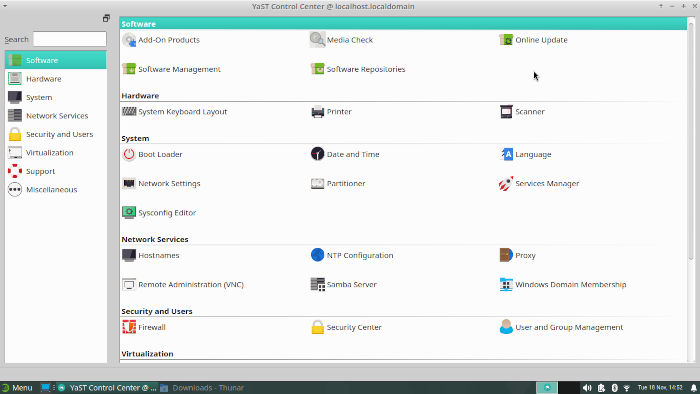
One of YaST’s functions is software management — we used it to install LibreOffice, the VLC media player, and the GIMP graphics editor, all flawlessly — a function that’s being taken over by Myrlyn.
The latter deserves special mention since it takes installing and maintaining the distro to another level. A main features of Myrlyn is that it can install, update, or remove either individual packages or groups of packages, and also allows users to configure software repositories. For example, we added a group of Xfce experimental software as a group with Myrlyn.
System management functions — network settings, firewall, services, system monitoring, and the like — are still handled by YaST, although they will be transitioned to Cockpit (a browser-based admin interface) after the platform is fully integrated into openSUSE Leap.
One of the words that come up in various reviews of Tumbleweed is “robust.” This is clearly an understatement when talking about performance. Software is activated immediately, and switching between apps takes place instantaneously. Multitasking is a breeze, with little if any delay. Not only was going between apps easy, but using cloud-based programs like Google Docs and Google Drive was very simple and straightforward.
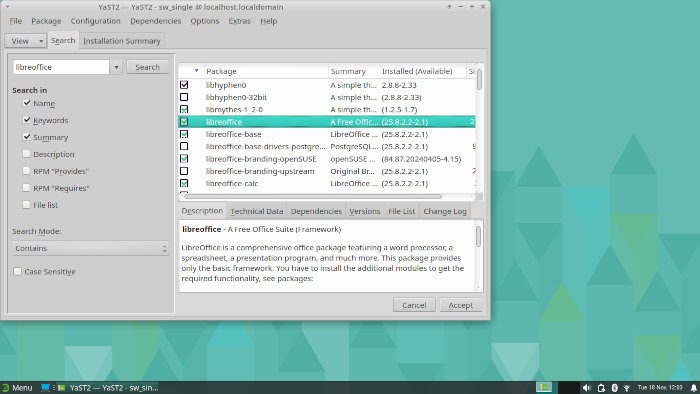
The distro’s facility for handling multi-tasking and the like prompted me to utilized a tool in the Systems menu called Sensor Viewer to monitor each laptop’s temperature. While running up to five programs at a time — and going back and forth to them — neither of the two laptops broke a sweat, or went above 50 degrees Celsius. A minor detail? Perhaps, but it is endearing for a distro to handle what is thrown at it with such aplomb.
One more thing: I gave GhostBSD Xfce a little grief last week for the operating system’s implementation of the DE not providing two panels – one main panel at the top and one row of software icons on the bottom, which is common for Xfce-based distros. It would not be fair to give openSUSE a pass, as it is guilty of this shortcoming as well. In fairness, I ended up switching the bottom panel to the top and providing myself a row of icons on the bottom. Different strokes and all that…

Final Thoughts
One would expect that a distro with decades under its belt would easily deliver top quality and stellar performance, and openSUSE clearly does not disappoint in this regard. In fact, if it included a couple of extra apps by default – an email client would be a nice addition – it would probably be as close to the perfect distro as possible.
However – and you knew that was coming – openSUSE might want to seriously consider retooling their installer. A live version of Tumbleweed or Leap would be nice. But hey, I get it, openSUSE: You’re an established distro with decades of development under your belt, so it’s your way or the highway. But you could at least make some improvements around the networking aspect of the install experience, so it doesn’t trip up even some more experienced users.
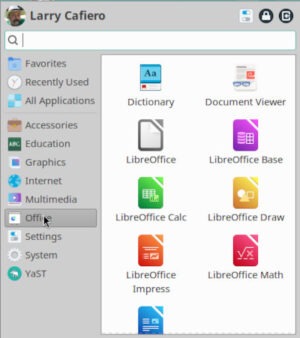
Installer aside, it goes without saying that openSUSE would make a great starter distro for new users, especially with the wealth of tools that a newbie could cut their teeth on. And with this wealth of tools, experienced users are not left wanting either. So it’s safe to say that openSUSE falls into the rare category of an ideal distro candidate for all levels of users.
If you want to try openSUSE, go to the Tumbleweed download page or the Leap download page.
Do you have a distro you think would make a great feature for FOSS Force’s Distro of the Week? Don’t be shy—let us know! Offer your suggestions in the comments below (or use the “contact us” link under our masthead) and we’ll make an effort to make it so… No suggestion is too mainstream or too niche—let us know what you’d like to see!
Things I like about openSUSE Tumbleweed… |
Things I don’t like about openSUSE Tumbleweed… |
|---|---|
|
|
And suddenly it’s time to take a little Steely Dan break…








Be First to Comment